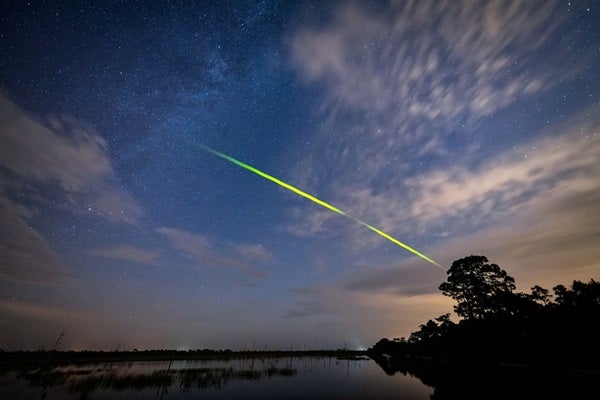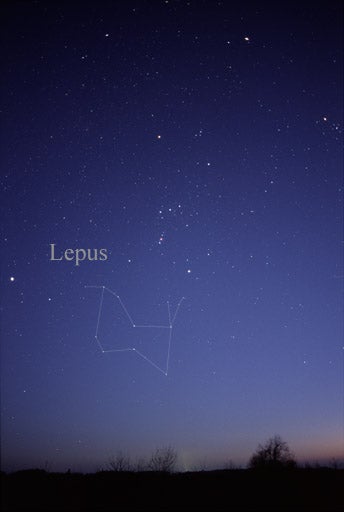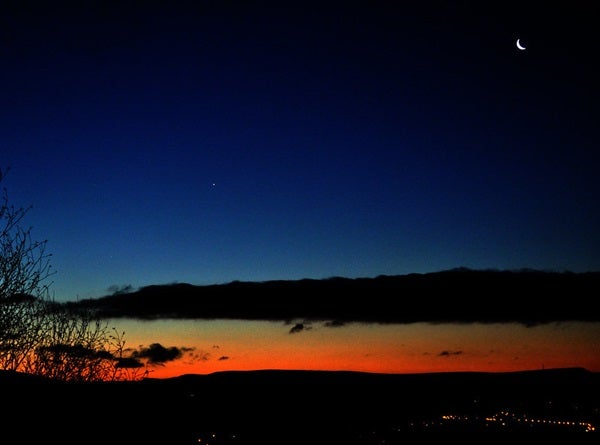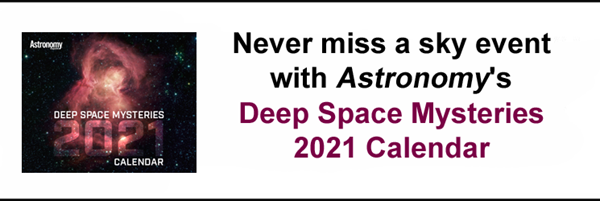The time between sunset and moonrise is perfect for keeping tabs on Jupiter and Saturn tonight. You’ll find them in the south within the boundary of Sagittarius the Archer, to the upper left of the handle of its Teapot asterism. Jupiter, the brighter of the pair, is magnitude –2.2, while Saturn glows a dimmer magnitude 0.6 to its east. They’re just over 4.5° apart.
If you’ve got a good scope and a camera capable of timed exposures, consider hunting for Pluto before moonrise as well. The magnitude 14 dwarf planet sits about 1° southeast of Jupiter; a one-minute exposure through an 80mm (or larger) refractor should net its dim glow.
We’ll come back later to check in on the giant planets, when a crescent Moon glides by the scene in just over a week.
Sunrise*: 6:35 A.M.
Sunset: 4:51 P.M.
Moonrise: 9:30 P.M.
Moonset: 12:03 P.M.
Moon Phase: Waning gibbous (69%)
*Times for sunrise, sunset, moonrise, and moonset are given in local time from 40° N 90° W. The Moon’s illumination is given at 12 P.M. local time from the same location.
Sky This Month.
Saturday, November 7
Among the royalty immortalized in the stars is Cepheus the King, husband to Cassiopeia and father of Andromeda. His house-shaped constellation is high in the north after dark tonight, and within its borders is the bright star cluster NGC 7160. This group of stars lies 4° east of Cepheus’ alpha star, Alderamin (magnitude 2.5). It’s an open cluster that astronomers estimate is less than 20 million years old and contains about 100 Suns’ worth of mass. Binoculars or a small scope will show this roughly 5′-wide cluster.
NGC 7160 is actually part of the larger Cepheus OB2 Association, a stream of forming stars you can track all the way from Cepheus back toward the Milky Way in Cygnus the Swan. If you’re observing from a location with clear, dark skies before the Moon rises tonight, see if you can find this arc of twinkling starlight with your naked eye.
Sunrise: 6:36 A.M.
Sunset: 4:50 P.M.
Moonrise: 10:34 P.M.
Moonset: 12:48 P.M.
Moon Phase: Waning gibbous (59%)
Sunday, November 8
Asteroid 3 Juno is in conjunction with the Sun at 4 A.M. EST. Later this morning, at 8:46 A.M. EST, the Moon reaches Last Quarter as it wanes from Full toward New.
Comet C/2020 M3 (ATLAS) glides between Orion the Hunter’s three-star belt and his left knee, magnitude 0.2 Rigel, tonight. After dark, step outside to find the comet just 1° south-southwest of magnitude 3.4 Eta (η) Orionis. According to the Comet Observation database, ATLAS is roughly magnitude 8 — viewable with binoculars or a small telescope. Its coma stretches about 8′ across. For the best visibility, consider staying out overnight and watching it into the early morning hours of the 9th.
This comet is moving quickly through Orion from night to night, and it’s headed north for a rendezvous with Bellatrix next week. ATLAS has already made its closest approach to the Sun (October 25) and will make its closest approach to Earth on the 14th, when it comes within 0.4 astronomical units of our planet. (One astronomical unit is the average Earth-Sun distance.)
Sunrise: 6:38 A.M.
Sunset: 4:49 P.M.
Moonrise: 11:42 P.M.
Moonset: 1:28 P.M.
Moon Phase: Waning crescent (48%)
At the feet of the well-known constellation Orion sits Lepus the Hare. Formed by roughly a dozen stars, this dim figure fully clears the horizon just before 10 P.M. local time and is visible even from suburban locations. Some stories depict Lepus as being hunted by the Hunter or his dogs, Canis Major and Canis Minor — and you’ll see the two hounds clearing the horizon shortly after. But alternate tales claim Lepus crouches at Orion’s feet for protection from other hunters that might consider him prey.
The constellation’s brightest (alpha) star, magnitude 2.6 Arneb, is about 9° southwest of Orion’s right knee, Saiph. (His left knee, Rigel, is much brighter.) But through binoculars, magnitude 3.6 Gamma (γ) Leporis might be the most distinct of Lepus’ stars, with a companion star glowing at magnitude 6 just 97″ to the north. The two are slightly different colors, with brighter Gamma A appearing yellower than dimmer Gamma B, which looks more orange.
Nearby is M79, a globular cluster that sits a little less than 4° south of Nihal (Beta [β] Leporis). One of the few good winter-sky globulars, this densely packed group of some 100,000 stars may once have been part of the Canis Major Dwarf Galaxy — the closest galaxy to the Milky Way that astronomers have found to date.
Sunrise: 6:39 A.M.
Sunset: 4:48 P.M.
Moonrise: —
Moonset: 2:03 P.M.
Moon Phase: Waning crescent (37%)
Tuesday, November 10
Mercury reaches greatest western elongation (19°) from the Sun at noon EST today. The planet is an early morning object, rising about an hour and a half before the Sun. Today, it’s glowing at magnitude –0.5 and is roughly 13° high by 6:15 A.M. local time. Above it, the bright planet Venus is 25° high. With optical aid, you’ll see that Mercury is nearly 60 percent lit and spans 7″. Venus, which stretches 13″ across, is 84 percent lit.
We’ll check back in with these planets later in the week, when the crescent Moon joins them. Our satellite isn’t hard to find, though — it’s northwest of the planets, higher in the sky as it floats near the hindquarters of Leo the Lion. The Moon is positioned this morning on a line drawn between Iota (ι) and Rho (ρ) Leonis, both magnitude 4, and sits south-southwest of the magnitude 3 star Chertan.
Sunrise: 6:40 A.M.
Sunset: 4:47 P.M.
Moonrise: 12:52 A.M.
Moonset: 2:34 P.M.
Moon Phase: Waning crescent (27%)
Wednesday, November 11
Even as the Leonid meteor shower is ramping up for a treat later this month, the lesser-known Northern Taurid meteor shower peaks overnight tonight and into tomorrow morning. These meteors are debris left by Comet 2P/Encke; they zip through our atmosphere at about 18 miles (29 km) per second. Observers can expect to spot roughly five to 10 meteors per hour during the shower’s peak. Admittedly, that’s not much more than the average background rate of meteors (seven per hour) this time of year, but bright fireballs are more likely during showers.
The best time to look for shower meteors is late tonight and early tomorrow morning, when Taurus is high in the sky. You’ll find the radiant about 2.5° southeast of the familiar Pleiades (M45). Even if the Northern Taurids put on a poor show, this beautiful open cluster is a rich region to explore with binoculars or any size scope. With the Moon a mere 15 percent lit, it’s also a great night to see if you can spot any nebulosity between the cluster’s brightest stars. This dim, wispy glow comes from gas and dust that reflects, rather than absorbs, the nearby starlight.
Sunrise: 6:41 A.M.
Sunset: 4:46 P.M.
Moonrise: 2:04 A.M.
Moonset: 3:04 P.M.
Moon Phase: Waning crescent (17%)
Thursday, November 12
The Moon passes 3° north of Venus at 4 P.M. EST. A little more than two hours before dawn, eager skywatchers will find them rising in the east, just over 6° apart. Venus is blazingly bright at magnitude –4 and sits very close to magnitude 4.4 Theta (θ) Virginis in Virgo the Maiden. The two are less than 0.5° apart.
Before the sky grows too light, look North of Virgo for the Big and Little Dippers — both asterisms within the larger Ursa Major and Ursa Minor constellations, respectively. This morning, the Little Dipper appears upright, which means the Big Dipper appears nearly upside-down. As you look north, you’ll see the Big Dipper to the upper right of its littler counterpart. Directly beneath the Little Dipper is the twisting form of Draco the Dragon, whose alpha star Thuban (located about 10° south of the right-hand edge of the Little Dipper’s cup) once sat above Earth’s north pole as its pole star.
Sunrise: 6:42 A.M.
Sunset: 4:46 P.M.
Moonrise: 3:18 A.M.
Moonset: 3:34 P.M.
Moon Phase: Waning crescent (9%)
The Moon passes 1.7° north of Mercury at 4 P.M. EST. Catch the pair in the hour or so before sunrise this morning in Virgo, where they’re rising in the east, preceding our star. At that time, the delicate crescent Moon stands 5° above Mercury, which glows an easy magnitude –0.7, only slightly dimmer than it appeared just days ago. Mercury now sits just 2° west of magnitude 4 Kappa (κ) Virginis.
Nearby is blazingly bright Venus, now about 1.5° southeast of Theta Virginis. Glance down a bit and you won’t be able to miss Spica, Virgo’s brightest star (magnitude 1).
You should be able to follow the scene well into morning twilight.
Sunrise: 6:34 A.M.
Sunset: 4:45 P.M.
Moonrise: 4:33 A.M.
Moonset: 4:05 P.M.
Moon Phase: Waning crescent (3%)













